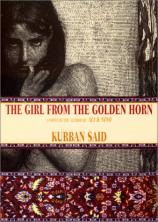The Girl From the Golden Horn
Review
The Girl From the Golden Horn
In these times of strained relations between Muslims and
Christians, Kurban Said's second book, written in 1938, foreshadows
and underscores Kipling's adage: East is East and West is West but
never the twain shall meet.
The time is 1928 and the Turkish Ottoman Empire has been
overthrown; Turkish royalists have sought sanctuary in Europe and
America. Asiadeh, a bright and talented young Turkish woman with
royal Osman blood flowing in her veins, is a student of languages
in Berlin, where she lives with her exiled father. She was promised
in marriage to a Turkish prince, and her future in the harem of the
Sultan's palace was secure. Out of her element and ailing in modern
Berlin, she meets and is attracted to Dr. Hassa, a Viennese throat
doctor whose western ways delight but frighten her as they fall in
love. Asiadeh writes her promised prince, begging him to release
her from her vows, but has no hope of the letter ever reaching him,
as he has vanished. He is living out his exile under a western name
in New York City as an American screenwriter and, while he has
assimilated more successfully to the west than Asiadeh, he longs as
much as she does for the high desert plains of Anatolia.
Asiadeh makes a valiant effort to play the part of a Viennese
doctor's wife but drifts further and further from the strange
Western ways of one of the most vital cities in post World War I
Europe. The safety of the veil and the harem call to her as she is
thrown into Viennese high society. Said understands, better than
most contemporary writers, the mind of the cosseted Muslim women
and the fierce protectiveness of their men.
As in his first poignant novel, ALI AND NINO, Said uses a love
story between members of two cultures to portray the overwhelming
conflict when civilizations clash. No matter how much the
star-crossed lovers adore one another, the chasm that exists
between their heritage, languages, traditions, and morals are vast
indeed and perhaps impossible to overcome. It is easy to juxtapose
the surface love story with the trials of emerging Mideast nations
as westernization emerges as a volatile mixture of enlightenment
and evil.
The story behind the books written by Kurban Said is almost as
fascinating as the tales he wove. Said's first book was ALI AND
NINO, first published in the original German before the outbreak of
World War II. It was discovered in a Vienna used book store several
years ago and published in the United States in 1999. Said is
thought to be Lev Naussimbaum (alias Essad Bey), son of a German
governess and a Jewish businessman. He changed his religion and his
name in the early Nazi years, and it is believed that the books
were published through the help of the Austrian Baroness Elfriede
Ehrenfels. THE GIRL FROM THE GOLDEN HORN was originally published
under her name, but is now acknowledged to be the work of Said,
whose relationship with the Baroness has never been entirely
clear.
Reviewed by Roz Shea on January 22, 2011
The Girl From the Golden Horn
- Publication Date: November 12, 2001
- Genres: Fiction
- Hardcover: 256 pages
- Publisher: Overlook Hardcover
- ISBN-10: 1585671738
- ISBN-13: 9781585671731










